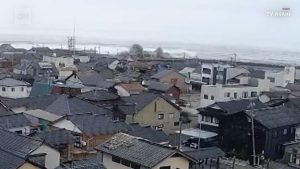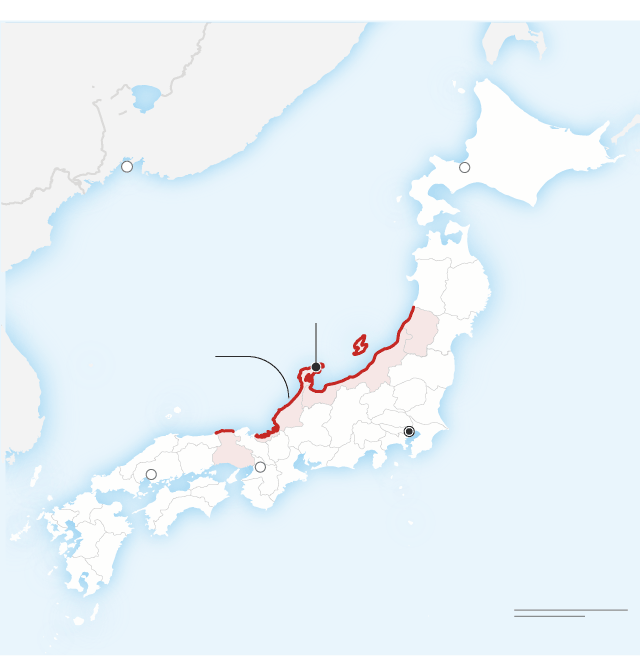A 7.5 magnitude earthquake struck western Japan on Monday afternoon, collapsing buildings, causing fires and triggering tsunami alerts as far away as eastern Russia, prompting orders for residents to evacuate affected coastal areas of Japan.
The earthquake struck at 4:10 p.m. local time at a depth of 10 kilometers (6 miles) in the Noto Peninsula of Ishikawa prefecture, according to the United States Geological Survey (USGS).
The Japan Meteorological Agency immediately issued a tsunami warning along coastal regions of western Japan, and the first waves were reported hitting the coast just over 10 minutes later.
Some of the first reports came from the city of Wajima in Ishikawa prefecture, which saw tsunami waves of around 1.2 meters (3.9 feet) around 4:21 p.m., according to Japanese public broadcaster NHK. No immediate damage was reported. The tsunami warnings along portions of Japan’s western coast were later removed.

Suzu city officials in Ishikawa told CNN that buildings have been damaged and there were reports of injuries. Police in the city said some people were trapped in damaged houses, according to NHK. No deaths have been reported so far.
Hospital officials in Suzu said they received injured people, adding that some doctors were unable to make it to work because of damaged roads, NHK reported.
The Japan Meteorological Agency issued a “major tsunami warning” – the first since 2011’s devastating earthquake – for Noto but later downgraded it to a “tsunami warning.”
Tsunami warnings were later canceled as the threat of further tsunami waves diminished, though tsunami advisories for waves up to 1 meter (3 feet) continue.
Under Japan’s tsunami warning system, waves expected less than 1 meter fall under “tsunami advisory,” while those expected up to 3 meters fall under “tsunami warning” and waves expected above 5 meters fall under “major tsunami warning.”
In a televised address earlier, Japan’s Chief Cabinet Secretary Yoshimasa Hayashi urged people living in areas under tsunami warnings to evacuate to higher ground.
‘The whole room was shaking’
Footage from NHK showed cameras shaking vigorously as waves slammed into the coastline when the quake hit Ishikawa prefecture.
Houses were also rocked by the earthquake, with images showing collapsed roofs and shaken foundations.
An eyewitness reported seeing people “panicked” as the ground started shaking while he waited for a bus home in western Japan.
The powerful quake was followed by a series of strong aftershocks, according to the USGS.
A 6.2 magnitude aftershock at a depth of 10 kilometers (6 miles) struck at 4:18 p.m. local time around 4 kilometers (2.4 miles) southwest of Anamizu, according to the USGS.
Some 58 kilometers (about 36 miles) away, tremors of 5.2 magnitude were recorded, and another 5.6 magnitude aftershock was reported closer to the initial quake, according to the USGS.
The country’s weather agency warned that powerful aftershocks could continue over the next three days to a week, and cautioned against potential building collapses and landslides.
The defense ministry dispatched 1,000 military personnel to help the rescue and recovery efforts, Defense Minister Kihara told reporters.
Japanese Prime Minister Fumio Kishida said authorities were working to assess potential damage in affected areas.
We have immediately set up the Prime Minister’s Office of Response – Disaster Counter Measure HQ. Putting human lives as priority, we are making every effort to assess damages – putting forth all efforts in disaster response,” the prime minister wrote on X, formerly Twitter, Monday.
Tsunami waves reported
Waves of less than a meter were reported in a number of other areas along Japan’s western coast, including 80 centimeter waves in Toyama city, 40 centimeter waves in Kashiwazaki and Kanazawa port, and 20 centimeter waves in Tobishima island and Sado island.
This shows a fire occurred following an earthquake in Wajima, Ishikawa prefecture, Japan Monday, Jan. 1, 2024. Japan issued tsunami alerts and told people to evacuate seaside areas after a series of strong quakes on its western coastline Monday. (Kyodo News via AP)
The South Korean Meteorological Administration said it was watching for possible sea level changes in the east coast areas of Gangneung, Yang Yang and Goseong of Gangwon Province and Pohang City.
A tsunami threat was also declared in the eastern Russian cities of Vladivostok, Nakhodka, and the island of Sakhalin – as the areas face the Sea of Japan – Russian state media TASS reported. No evacuations have been reported so far.
